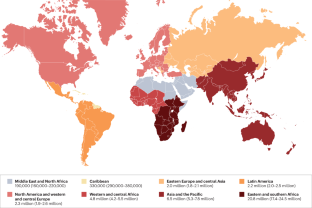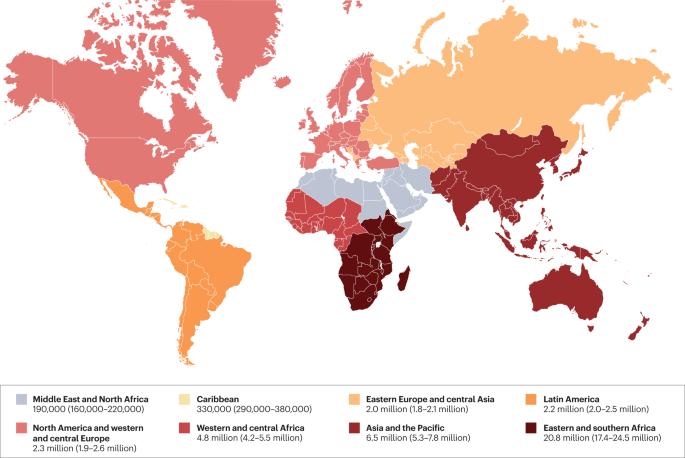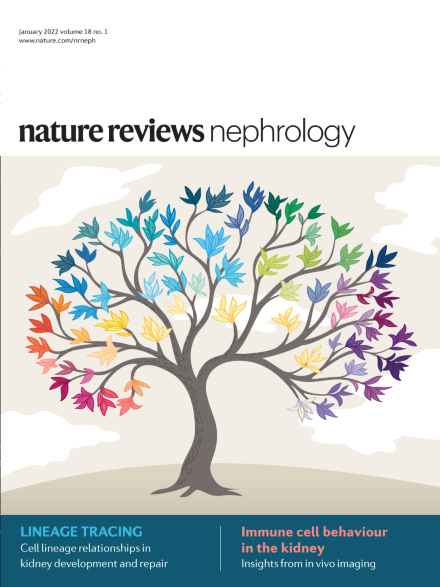不断变化的艾滋病毒相关肾脏疾病状况
IF 28.6
1区 医学
Q1 UROLOGY & NEPHROLOGY
引用次数: 0
摘要
艾滋病毒疫情给全球数百万人带来了灾难,自疫情开始以来,约有 4 000 万人死亡。抗逆转录病毒疗法(ART)的出现改变了数百万艾滋病毒感染者的预后,使艾滋病毒感染诊断不再自动导致死亡。然而,艾滋病毒感染者的发病率和死亡率仍然很高。艾滋病病毒可直接感染肾脏,导致艾滋病病毒相关性肾病(HIVAN)--一种以荚膜细胞和肾小管损伤为特征的疾病,与肾衰竭风险增加有关。有报告称,HIVAN 主要发生在非洲裔人群中,因此人们发现这种疾病与 APOL1 风险等位基因有关。抗逆转录病毒疗法的出现大大降低了 HIVAN 的发病率,但也有报道称其他肾脏病变(如局灶节段性肾小球硬化症)以及与高血压和糖尿病等老年并发症相关的病理状况的发病率有所增加。过早开始抗逆转录病毒疗法也会导致更长时间的药物累积暴露,增加肾毒性的可能性。大量文献支持对艾滋病病毒感染者进行肾移植,与接受慢性透析的患者相比,肾移植患者的存活率显著提高,与艾滋病毒阴性的肾移植受者相比,肾移植受者和患者的长期存活率相似。本文章由计算机程序翻译,如有差异,请以英文原文为准。


The changing landscape of HIV-associated kidney disease
The HIV epidemic has devastated millions of people globally, with approximately 40 million deaths since its start. The availability of antiretroviral therapy (ART) has transformed the prognosis of millions of individuals infected with HIV such that a diagnosis of HIV infection no longer automatically confers death. However, morbidity and mortality remain substantial among people living with HIV. HIV can directly infect the kidney to cause HIV-associated nephropathy (HIVAN) — a disease characterized by podocyte and tubular damage and associated with an increased risk of kidney failure. The reports of HIVAN occurring primarily in those of African ancestry led to the discovery of its association with APOL1 risk alleles. The advent of ART has led to a substantial decrease in the prevalence of HIVAN; however, reports have emerged of an increase in the prevalence of other kidney pathology, such as focal segmental glomerulosclerosis and pathological conditions associated with co-morbidities of ageing, such as hypertension and diabetes mellitus. Early initiation of ART also results in a longer cumulative exposure to medications, increasing the likelihood of nephrotoxicity. A substantial body of literature supports the use of kidney transplantation in people living with HIV, demonstrating significant survival benefits compared with that of people undergoing chronic dialysis, and similar long-term allograft and patient survival compared with that of HIV-negative kidney transplant recipients. The availability of antiretroviral therapy has led to a transformation in the spectrum of kidney diseases associated with HIV infection. This Review describes the changing pattern of kidney diseases associated with HIV infection, their risk factors, methods of evaluating kidney function in patients with HIV and current therapeutic approaches.
求助全文
通过发布文献求助,成功后即可免费获取论文全文。
去求助
来源期刊

Nature Reviews Nephrology
医学-泌尿学与肾脏学
CiteScore
39.00
自引率
1.20%
发文量
127
审稿时长
6-12 weeks
期刊介绍:
Nature Reviews Nephrology aims to be the premier source of reviews and commentaries for the scientific communities it serves.
It strives to publish authoritative, accessible articles.
Articles are enhanced with clearly understandable figures, tables, and other display items.
Nature Reviews Nephrology publishes Research Highlights, News & Views, Comments, Reviews, Perspectives, and Consensus Statements.
The content is relevant to nephrologists and basic science researchers.
The broad scope of the journal ensures that the work reaches the widest possible audience.
 求助内容:
求助内容: 应助结果提醒方式:
应助结果提醒方式:


